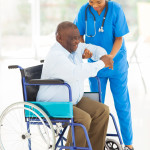Stroke is the Third leading cause of death for African Americans. The risk of having a first stroke is nearly twice as high for blacks than for whites, and blacks are more likely to die following a stroke than are whites. The country’s highest death rates from stroke are in the southeastern United States. This is where the highest concentration of African Americans (Figure 4) is found, according to the 2010 U.S. Census. Jay Harold will talk about the warning signs and questions to ask a possible stroke victim during an emergency. Jay Harold discovered that the RESCUE fact sheet on Strokes provided excellent, easy to read information on the subject and was used extensively in this post.
What’s a Stroke?
A Stroke occurs when blood flow to a part of the brain stops. This causes brain cells to die. The result can be a loss of memory, speech and/or movement.
The two types of stroke are:
- Ischemic (is-KEM-ik) – A stroke caused by a clot blocking a blood vessel to the brain. This prevents the brain from getting the oxygen it needs. It is the most common type of stroke.
- Hemorrhagic (hem-o-RAJ-ik) – A stroke caused when a blood vessel to the brain bursts. This causes bleeding within the brain.
5 Warning Signs of a Stroke
Stroke symptoms happen very fast. Call 9-1-1 immediately if you or someone you know has any of the following signs or symptoms.
- Numbness or weakness of face, arm or leg (mainly on one side)
- Trouble seeing in one or both eyes
- Trouble walking, dizziness or loss of balance
- Confusion or trouble talking or understanding speech
- A bad headache with no known cause
These symptoms may last more than a few minutes. They may start, briefly go away, and then return. Remember, a Stroke is a Medical Emergency. Every minute counts.
3 Questions to ask Stoke Victim
You can recognize a stroke by asking 3 simple questions. Remember “S-T-R.”
- S – Ask the person to SMILE.
- T – Ask the person to TALK or speak a simple sentence (clearly). Example: “It is sunny out today.”
- R – Ask the person to RAISE both arms together.
If the person has trouble with any one of these three steps, call 9-1-1 right away.
Strokes kill almost 130,000 people a year in the United States. Stroke is also a leading cause of severe long-term disability. Jay Harold knows how a Stroke can affect the lives of the patient and their caregivers. Modifications must often be made inside the home to reflect the mental and physical limitations of the Stroke patient. Fortunately, there are many support services available for the Stroke victims and the caregivers. The National Stroke Association provides many resources for both the patient and caregiver.
Future posts from Jay Harold will discuss the risk factors and what diseases or conditions increase your risk of Stroke. Jay Harold is concerned about your health and is always looking for ways to improve it.
Play the free “Slow Roll Through Civil Rights” Game found on the Jay Harold website. Enjoyed this post? Share it and read more here.





